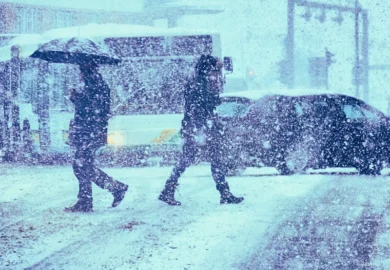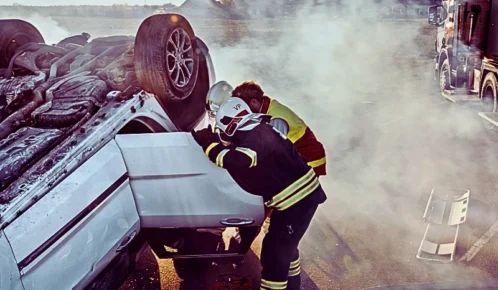Blocked bike lanes caused by snow often lead to cycling accidents during winter. Slippery sidewalks and poor visibility create dangerous conditions that put cyclists at greater risk of slipping or getting struck by vehicles. Snow can also obscure hazards, making safe navigation difficult.
Table of Contents

If you’ve been involved in an accident due to blocked bike lanes, you have the right to seek compensation for your losses. Contact Ankin Law at 312-600-000 for legal assistance.
Snow-Covered Bike Lanes Endanger Cyclists in Chicago
Snowy weather creates dangerous road conditions, especially for cyclists. Slippery bike lanes, reduced visibility, and snow-covered roads heighten the risk of accidents. Cyclists face increased chances of slipping on icy surfaces or getting hit by vehicles that struggle to stop on snow-packed streets. Moreover, snow and ice can hide winter bike lane hazards in Chicago, complicating navigation for both cyclists and drivers. Here are some reasons why snow-covered bike lanes are risky for cyclists:
Reduced Traction
Snow-covered bike lanes pose dangers for cyclists due to slippery surfaces that reduce traction. This can lead to loss of control while riding, braking, or turning, increasing the risk of falls and accidents. Cyclists may be unable to stop in time or swerve to avoid hazards due to longer stopping distances in winter conditions.
Hidden Hazards
Snow can hide road markings and obstacles in bike lanes, raising the risk of unforeseen dangers. Bridges, painted surfaces, utility covers, and other metal or wooden areas on the road or trail become slippery when wet. Moreover, when snow accumulates in a lane, it can obscure these hazards, making it difficult for cyclists to see and avoid them, which could lead to accidents if they inadvertently ride into them.
Poor Visibility
Falling snow can reduce visibility for both drivers and cyclists. It scatters and reflects light, creating a “whiteout” effect that blurs object distinctions, especially in strong winds. For drivers, foggy windshields and snow-covered mirrors further impede their view, making it harder to spot cyclists, who are already less visible. This heightened obscurity increases the risk of collisions, as both cyclists and drivers struggle to see hazards.
Forced Road Usage
Bike lanes are often not cleared during snowy weather, and when roads are plowed, snow can be pushed into these lanes, making them unsafe for cyclists. This forces riders into more dangerous areas such as the road, increasing the risk of accidents.
What Chicago Cyclists Should Know About Winter Riding Risks
In 2021, the Illinois Department of Transportation recorded over 2,350 bicycle collisions, resulting in at least 300 serious injuries. Nationwide, in 2019, around 16,884 cyclists were injured, with 4,433 either seriously hurt or killed. Winter cycling is especially hazardous, leading to about 10,000 emergency room visits annually. Accidents during this season are more frequent, primarily due to reduced visibility, icy conditions, and shorter daylight hours, in which cyclists may be injured commuting to work or for any other purpose. Cyclists should be aware of the following when riding in bad weather.
- Poor weather conditions can make it harder for drivers to notice you. Utilize front and rear lights and don high-visibility, reflective gear to enhance your visibility.
- Wet weather diminishes your grip on the road. Exercise increased caution, particularly when navigating turns.
- Wet conditions can lengthen your stopping distance. Gently brake to clear moisture from your rims before applying the brakes fully to come to a stop.
- The first few moments of rainfall or snowfall can create the slickest roads due to oil from vehicles mixing with the rainwater.
- Snow and ice present traction challenges. Lowering tire pressure can help. Wide tires, knobby mountain bike tires, or studded tires are ideal for winter riding.
- Exercise heightened caution when biking in rain or snow, especially on steep inclines or declines. Surfaces like bridges, painted areas, utility covers, and other metal or wooden surfaces become slippery when wet.
Legal Options for Cyclists Injured Due to Snowy Bike Lanes
Following an incident on a snowy bike lane, you have legal avenues available for obtaining compensation for your injuries. There are several options for seeking compensation for your damages:
Personal Injury Claims
Following an accident, you can pursue a personal injury claim against the party responsible for the accident to seek compensation for your injuries caused by blocked bike lanes. In icy conditions, cycling accidents may involve several parties. It may be difficult to know who to sue for an accident caused by a blocked bike lane. Parties against whom you can file a personal injury claim are:
Drivers
Drivers must handle their vehicles carefully, particularly when road conditions are dangerous. In situations with snow or ice, it’s crucial for drivers to lower their speed, extend their stopping distance, and stay alert for pedestrians, cyclists, and other hazards. A driver may be found at fault for an accident if they do not yield to a pedestrian or cyclist in a crosswalk, drive too fast on slippery surfaces, or engage in reckless driving. Even if road conditions played a role in the incident, the driver is still responsible for maintaining safe and responsible driving practices.
Property Owners
In Chicago, it is the duty of property owners to remove snow from the sidewalks next to their properties within a designated timeframe. This responsibility falls on homeowners, businesses, and municipal entities alike, particularly in winter conditions. They must ensure that sidewalks and walkways are cleared of snow and ice promptly. If a property owner neglects to adequately salt, shovel, or treat the sidewalks, they could be held liable for any injuries that occur if a pedestrian or cyclist slips and falls, or has an accident.
Municipality or City
City liability for bicycle accidents may exist for failing to maintain public property, such as roads and sidewalks, if this neglect leads to injuries. In Illinois, municipalities must clear snow and ice to ensure safe transportation year-round. While property owners are responsible for their sidewalks, the municipality is responsible for areas not owned by individuals. The Chicago Department of Transportation (CDOT) handles snow removal in protected bike lanes. Residents can report bike lanes that have not been cleared within 15 hours of a snow event through a “Snow-Uncleared Sidewalk Complaint” via app, website, or phone.
Insurance Claims
Filing insurance claims is generally more advantageous than pursuing litigation for personal injury cases because it tends to be a quicker, more efficient process with less legal intricacy, lower expenses, and a greater chance of achieving a positive result. Insurance coverage may apply in various bicycle accident situations:
- Collision between two cyclists: If you are involved in an accident with another cyclist or pedestrian, and you are not at fault, the at-fault party’s personal liability insurance may cover your medical expenses and bike damage.
- Accident involving a bicycle and a motor vehicle: If a car hits you while riding your bike, the auto liability insurance of the driver who caused the accident may cover your injuries and damages.
- If you are at fault in a bike accident: Your personal liability insurance might cover the damages and injuries you cause, up to the limits of your policy.
- Collision with a stationary object or slip and fall: If you crash into a tree, pothole, parked car, curb, or any other object while riding, or if your bike slips due to ice or snow, your health insurance may help with your medical expenses.
Approach your bike accident in the same way you would a car accident. At the site of the incident, follow the usual steps: capture photos and exchange insurance details with anyone else involved. Remember, even if you don’t feel hurt right away, it’s important to seek medical attention, as you may still have injuries.
Proving Liability
Establishing liability in a pedestrian accident, especially in snow, can be complex. Gathering strong evidence is crucial to prove negligence. Witnesses can testify about the conditions and driver behavior, while traffic cameras may capture vital footage. Promptly requesting this footage can help determine fault. For snow-covered bike lanes, records on snow removal practices can demonstrate the responsible party’s negligence in ensuring cyclist safety. Time-stamped photos of the scene, highlighting hazardous conditions, are essential for proving liability and awareness of risks.
Contact a Personal Injury Lawyer
After a pedestrian accident, one of the most important steps you can take is to contact a Chicago cycling accident attorney. A bicycle accident lawyer knowledgeable about snowy weather-related accidents can enhance your chances of fair compensation.
A car accident lawyer can investigate the accident by gathering key evidence like witness statements and police reports, which is vital, especially in adverse weather conditions. Insurance companies often try to minimize payouts, so having a personal injury lawyer can ensure you receive a fair settlement. If your case goes to trial, legal representation will prepare you to present evidence and argue effectively in court. Contact us at Ankin Law for an attorney who can help you seek compensation after your cycling accident.



